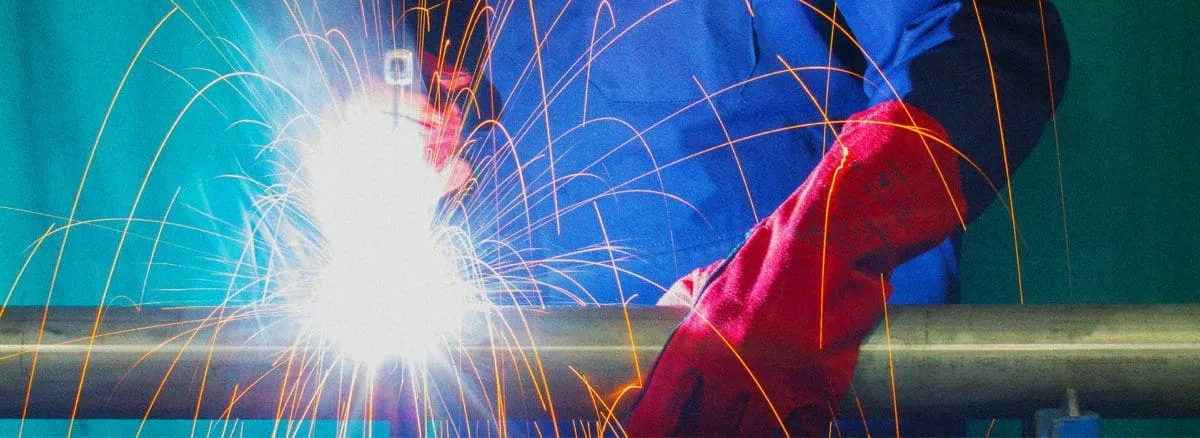

If you don't work in the industry, you might think items being welded are flat on a table. You may think the engineer has the freedom to move around the object in front of them. But 90% of the time, that's not the case.
Items may be fixed overhead, vertically along a wall, buried underground or horizontally on the floor. Some of these items may not have the ability to be moved, so welding cannot always be completed in the same position.
Over the years, engineers have tested and created positions to allow for these challenges. As a result, they are the most reliable welding positions for the welder to perform the task.
The four main welding positions are:
Some Welding processes can use all four welding positions. Some can only use one or two. So choosing the correct method and welding type is critical to the job.
Welding Symbol ISOWelding Symbol ASMEWelding PositionPA1FFlat PositionPA1GFlat PositionPB2FHorizontal PositionPC2GHorizontal PositionPF3G DownhillVertical PositionPG3G DownhillVertical PositionPD4FOverhead PositionPE4GOverhead PositionPH5G UphillHorizontal PositionPJ5G DownhillHorizontal PositionH-L0456G Uphill45 Degree PositionJ-L0456G Downhill45 Degree Position
The flat position is the easiest and most sought after method. It's the first one that people new to welding learn. As the name suggests, the metals joined are placed flat, and the weld follows a horizontal direction. The weld performed is on the upper side of the joint. This position is also known as Downhand.
The following three welding positions are referred to as "Out Of Position" because they require many more skills to complete. These are the Horizontal, Vertical and Overhead.
Like the Vertical and Overhead positions, the Horizontal requires a lot of skill to perform correctly. The weld axis is horizontal, but depending on the position determines the type of weld.
If the vertical and horizontal piece of metal meets at a 90-degree angle, you require a Fillet Weld.
If the weld face is along a vertical plane, then you'll need a Groove Weld.
The overhead position weld is the most challenging position to work as It's performed above the welder. The welder will have to angle themselves and the equipment to reach the joints.
In the overhead position, the metal can drop or sag from the plate. To avoid this, you can keep the puddle of molten metal small. When the metal sags, it creates a crown.
The Uphill and Downhill positions pertain to the direction of weld travel.
The Uphill position starts and the bottom and goes up. Uphill progression is typically considered to make a more sturdy joint but has a higher potential for burn through.
Downhill starts at the top and goes down. It produces less penetration (thinner material or root passes) because gravity pulls the molten pool down, so you have to move quickly.
It is a vertical-up position used for both butt and fillet welds. While welding, the angle of the torch is set at a 45° angle. The welder uses the metal from the lower part.
It is a vertical-down position used for fillet and butt welds. Welders used the metal from the upper part. This position is considered good in terms of productivity.
5G Uphill is a widespread way of welding pipes manually. In this position, the pipe is unable to be turned or rotated. The welder will be welding in three different positions—Overhead, horizontal, and finishing on the flat position.
The engineer should do the weld with specific equipment to combat the force of gravity. Like uphill, the welder will be welding in three different positions but reversed. First, starting in a flat position to horizontal, and finishing on the overhead.
The 6G is the most challenging position for a welder to perform. It is performed on weld tests to qualify a welder for all other positions. 6G is essentially the same as 5G but with the pipe at a 45º angle.
For more info on 6G welding, visit our post, “What Is 6G Welding?”
There are two main weld types, Fillet and (depending on which side of the pond you sit) Butt or Groove welds. Groove and butt welds are the same weld types, so the only difference is the name.
Butt weld is the International Organization for Standardization (ISO) term. Groove weld is the American National Standards Institute (ANSI) term.
In ASME, you will find that a number can identify the weld position and a letter to identify the weld type. The letter F is for Fillet and G for Groove.
Fillet welds are the most used type in the industry. A fillet weld joins two pieces of metal at a right angle to each other. It requires less joint preparation making it very cost-effective. There are three types of fillet joints. These are:
For more information about Fillet Welds, please click here.
Butt welds (Groove Weld in the USA) are the second most used type of weld. A butt weld is referring to the beads that deposit between two pieces of metal. There are several types of Butt joints, which can be single or double. These are:
For more information about Butt Joints, please click here.
For over 17 years, we have been offering our services to the industry. We provide a class 1 coded welding service nationwide. Our Codings give us the ability to cover most applications, positions and techniques. You can also read our article "What is the meaning of coded welding".
If you want more information on welding, visit our blog post "What Is Welding". More information on Welding Positions can be found here.
For more information on what we can offer, please visit our welding services page. You call us on 01902 861042 or email info@varlowe.co.uk.